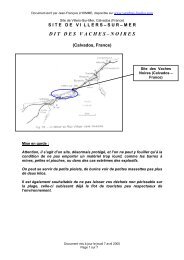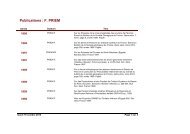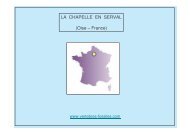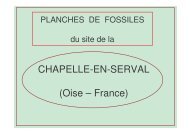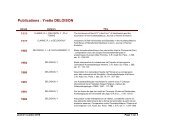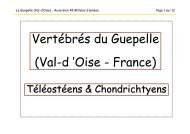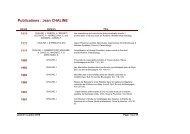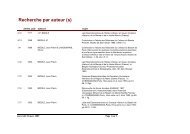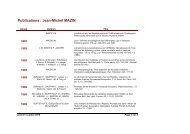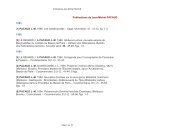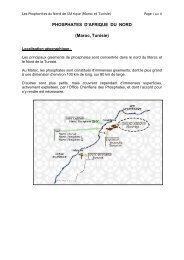Create successful ePaper yourself
Turn your PDF publications into a flip-book with our unique Google optimized e-Paper software.
D. Merle et al. / C. R. Palevol 1 (2002) 111–116the stratotypical area of the Stampian, Parisian facies ofthe Rupelian stage contains rare vertebrates, mainly originatingfrom the Étrechy pebbly sands for the marine fauna[2, 15, 20, 21] and from the Ormoy bed (sequence 21) [9]for the terrestrial fauna [12–14]. Secondly, the terrestrialfauna is the oldest one recorded in the Stampian.2. Geographical location and geological contextThe deposit is located near the road D153, 1.5 km westof Vayres-sur-Essonne (Fig. 1). The basis of the section(Fig. 2) shows: (1) a sandy limestone with molluscs molds,alternating with thinner argillaceous layers; (2) a fine sandwith Ophiomorpha burrows, truncated at the contact withthe overlying pebbly sand; (3) a complex unit of pebblysands, with the vertebrate remains. The fauna (molluscs,cirripeds and foraminifera) of the sandy limestone indicatesa marine infralittoral environment, more restricted atthe top of the bed. This marine limestone was recordedfrom La Ferté-Alais [1, 6, 7, 14] and Bouville (personal observations).At Bouville (Fig. 1), the invertebrate fauna includescharacteristic species from the Jeurs–Morigny sandbeds, indicating a Lower Stampian age (sequence 19 ofthe Eocene–Oligocene deposits) [9]. At La Ferté-Alais [15]and Bouville, like in the Vayres-sur-Essonne section, a similarfine sand unit is observed between the sandy limestoneand the pebbly sand. The first pebbly sand unit ofthe Stampian, already known from La Ferté-Alais [15],Baulnes [1, 7], prior to its record at Vayres-sur-Essonneand Bouville, has been synchronised with the Étrechy pebblysand beds, deposited on the Morigny sand beds, nearÉtampes [7]. The deposition of the Étrechy pebbly sandsfills a depression of the Cormeilles–Étrechy erosion surface[5, 17–19], and initiates the lowest sequence (sequence 20)of the Upper Stampian [9].3. Faunal content of the vertebrate bed3.1. FishesThe fish-fauna includes at least 21 elasmobranch speciesand 11 teleosts genera (Fig. 3). Carcharias cuspidata,C. acutissima, Myliobatis oligocaena and Sparus sp. arepredominant. Isurus flandricus, Paratodus benedeni, Chimaeridaeindet., Diplodus sp., Labrodon sp., Pimelodussp., Sphyraena sp., Sphyraenodus sp., Scarus sp. and aScombridae indet. are reported for the first time from theParis Basin. Only 58% of the fish-fauna from Vayressur-Essonneare known from the Stampian near Étampes,but higher percentages (81%) are registered with Maintenon(near Chartres) and Champlan (Essonne) (Fig. 3).The greatest affinities (87%) are with the North Sea BasinRupelian (Boom clays and Gellik sands, Belgium) [3, 22].The fish-fauna from Vayres-sur-Essonne, therefore characterisedby indisputable septentrional affinities, shares rareelements (Myliobatis, Diodon and Pimelodus) with thesouthern marine shallow-water facies of the Rupelian ofGaas (Landes, Aquitaine Basin).3.2. CheloniansAbout 50 eroded bone fragments have been found. Someof them belong to a Chelonidae (indet.), a Testudininei(indet.) and a Geoemydinei (indet.). The chelonians arevery rare in the Rupelian of the Paris Basin and, for thefirst time, these three taxa are recorded together.3.3. BirdsThe bird bones belong to a new species (new genusand, probably, new family), provisionally referred to theorder Pelecaniformes. This form, also found at Champlanand Pierrefitte (Essonne), is only represented by very longtarsometatarsi, having a very deep sulcus extensorius and awide, flattened distal extremity.3.4. Marine mammalsThe sirenians, attributed to the Dugongidae Halitheriumschinzii Kaup, 1838, are the most abundant mammals,represented by varied and isolated bones from juvenile andadult specimens. Most of the bones are eroded, but somevery fragile pieces are undamaged (lacteal and definitivepremolars, ear bones). H. schinzii was abundant in Europeduring the Lower Oligocene [23, 24].3.5. Terrestrial mammalsAbout 20 teeth of terrestrial mammals belong to Bachitheriumcurtum, Plagiolophus fraasi, Entelodon cf.deguilheimi and Anthracotherium magnum. The most abundantspecies is B. curtum, also occurring at Maintenon,Pierrefitte, and reported from the time level of Ormoy beds(at Itteville) [12, 13]. Most interesting is the discoveryof Plagiolophus fraasi, in the Paris Basin. This species,recorded from the mammal-zones of Villebramar (LowerStampian) and Montalbán (Upper Stampian), is absent inthe Heimersheim mammal-zone [12, 13]. The absence ofPlagiolophids is also noteworthy in the mammal localitiesnear Étampes, younger than those in Vayres-sur-Essonne,which are dated from the Heimersheim zone [13]. Theseobservations suggest that the Vayres-sur-Essonne faunamay be correlated with the Montalbán mammal-zone.4. Palaeoecological commentsThe vertebrate assemblage results from an accumulationof eroded bones, probably dragged by marine currents, andof better preserved bones more quickly buried, mixing diversifiedtaxa from environments of both sides of the shoreline.On the continent lived small browsers (Bachitheriumand Plagiolophus), the freshwater biotopes (lakes or rivers)being attested by a chelonian (Geomydinei indet.) and anamphibious mammal (Anthracotherium). In the sea, the numeroussirenians remains indicate a high development ofseagrass, which probably sheltered an autochthonous fishfauna(Diodon, Diplodus, Labrodon, Pimelodus, Scarus,Sparus and Sphyranea). An abundant invertebrate benthosis suggested by the exceptional number of Myliobatis remains.Other predators were present, as indicated by thefish-fauna, comprising benthic sharks (Squatina), nectobenthicsharks (e.g.: Carcharias and Notorhynchus), nec-112



